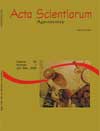<b>Efeito residual de novos inseticidas utilizados na cultura do tomateiro sobre <em>Trichogramma pretiosum</em> Riley, 1879 (Hymenoptera: Trichogrammatidae)</b> - DOI: 10.4025/actasciagron.v26i2.1888
Resumo
O objetivo do presente trabalho foi avaliar a ação residual dos inseticidas acetamipride, clorfenapir, imidaclopride, tiaclopride e tiametoxam sobre adultos de Trichogramma pretiosum Riley (Hymenoptera: Trichogrammatidae) e os efeitos subseqüentes sobre as gerações F1 e F2 desse parasitóide. Ovos de Anagasta kuehniella (Zeller) (Lepidoptera: Pyralidae) foram aderidos em cartelas de cartolina, inviabilizados e tratados por imersão nas caldas químicas e em água (testemunha) por cinco segundos. Uma, 24 horas e 48 horas após tratados, os ovos foram expostos ao parasitismo por um período de 48 horas, findo o qual, foram mantidos em câmara climatizada a 24±1oC, UR de 70±10% e 12 horas de fotofase até a emergência dos parasitóides. Clorfenapir e imidaclopride foram os compostos mais prejudiciais a T. pretiosum. Acetamipride e tiametoxam foram seletivos em favor desse parasitóideDownloads
DECLARAÇÃO DE ORIGINALIDADE E DIREITOS AUTORAIS
Declaro que o presente artigo é original, não tendo sido submetido à publicação em qualquer outro periódico nacional ou internacional, quer seja em parte ou em sua totalidade.
Os direitos autorais pertencem exclusivamente aos autores. Os direitos de licenciamento utilizados pelo periódico é a licença Creative Commons Attribution 4.0 (CC BY 4.0): são permitidos o compartilhamento (cópia e distribuição do material em qualqer meio ou formato) e adaptação (remix, transformação e criação de material a partir do conteúdo assim licenciado para quaisquer fins, inclusive comerciais.
Recomenda-se a leitura desse link para maiores informações sobre o tema: fornecimento de créditos e referências de forma correta, entre outros detalhes cruciais para uso adequado do material licenciado.




















































